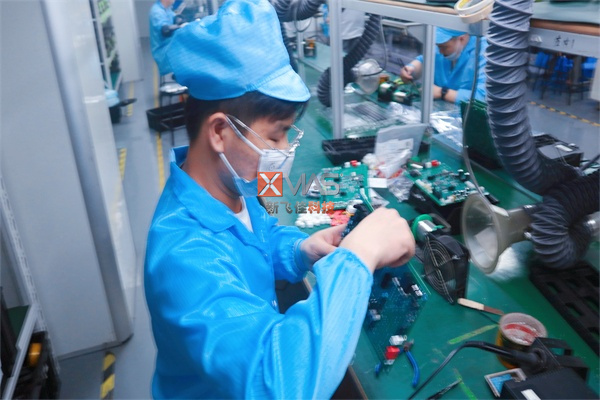Electric soldering iron is a commonly used welding tool in the early stages of circuit board processing. It is used for welding and assembling electronic components, wires, and can also weld some iron products and other items. In the process of circuit board processing, the soldering step of the electric soldering iron is an indispensable part. Do you know what usage methods and precautions soldering personnel need to master when using electric soldering irons? Below, the editor will briefly explain some common usage methods and precautions:
1、 Usage of electric soldering iron
First, place the electric soldering iron in the working area to preheat the soldering iron. Place the soldering iron head at a 45 degree angle on the solder pad and component pins, and heat the solder pad and component pins in advance. The tip of the soldering iron should avoid direct contact with the PCB without copper foil to prevent leaving marks on the board. Control the preheating time between 1-2 seconds.
After preheating, apply tin: Starting from the contact area between the component pins and the soldering iron, gently pull the tin wire until the tin is evenly distributed on the solder pad. When tin begins to melt, the feed rate of the tin wire should be controlled. After the tin completely covers the solder pad, remove the tin wire.
Note that the tin wire should not directly touch the soldering iron head to prevent the flux from burning. The tin plating process lasts approximately 1-2 seconds. Then remove the tin wire: continue to keep the soldering iron on the solder pad, wait for about 1-2 seconds, and then remove the tin wire again. Remove the soldering iron again: When the tin on the solder joint emits slight smoke, the soldering iron can be removed.
At this point, the solder joint should have completely solidified and the soldering area has been completed.
2、 Precautions for processing and welding circuit boards
Before using an electric soldering iron, check whether its rated voltage matches the power supply voltage to avoid damage caused by voltage mismatch.
2. The electric soldering iron should be properly grounded to ensure safety.
3. Do not tap, disassemble, or modify the electric heating part of the soldering iron at will.
4. Electric soldering iron should be used in a dry, non humid or rainy environment to prevent damage.
5. When disassembling the soldering iron head, turn off the power in a timely manner. After turning off the power, use the remaining heat to apply a layer of tin on the soldering iron head to protect it.
If an oxide layer is found on the soldering iron head, it should be lightly sanded with sandpaper, then powered on and immediately tinned on the soldering iron head.
7. Use a sponge to collect welding slag and solder beads, maintain appropriate humidity, and avoid excessive drying or wetting.
8. Whether before or after welding, the "5S" work should be done well: sorting, tidying, cleaning, and literacy. This not only ensures the cleanliness of the workplace, but also improves work efficiency and quality.
9. Welding requirements and process specifications for PCB boards should be followed, and appropriate welding should be selected based on different components. 12. Welding temperature and time. At the same time, it is important to avoid excessive or prolonged heating to avoid damaging the PCB board or causing poor soldering.
10. During the welding process, attention should be paid to maintaining the cleanliness and sharpness of the soldering iron head to ensure welding quality and efficiency. If the soldering iron tip experiences oxidation or blockage, it should be cleaned or replaced in a timely manner.
When welding large components or connectors, special attention should be paid to controlling the welding temperature and time to avoid problems such as PCB board deformation or solder joint virtual soldering. At the same time, it is necessary to ensure sufficient heat dissipation space to avoid damaging components or PCB boards due to overheating.
During the welding process, attention should be paid to protecting sensitive areas such as eyes and skin, avoiding prolonged contact with welding fumes or high-temperature soldering iron heads. At the same time, appropriate protective equipment should be worn, such as protective goggles, gloves, etc.
After completing the processing and welding of the circuit board, quality inspection and testing should be carried out to ensure that the welding quality and electrical performance meet the requirements. If welding defects or quality issues are found, they should be dealt with and resolved in a timely manner. At the same time, it is necessary to summarize the experience and lessons learned, improve welding skills and work efficiency.
Do you know any other methods and processing precautions besides the above? Welcome to explore together!


